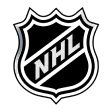NHL News
2025-26 NHL Season Opening Rosters

Image © Bob Frid-Imagn Images
The NHL season has arrived, and teams are locking in their cap-compliant opening rosters. We’ve updated each team’s lineup as moves are finalized as well as their cap situation for opening night. For the most current roster details, visit the PuckPedia Lineups page.
To better understand how teams are managing their rosters today, see:
- SOIR (Season-Opening Injured Reserve)
- LTIR (Long-Term Injured Reserve)
- Team Cap Hit Calculations & Accrued Cap Space
Eastern Conference
Atlantic Division
Boston Bruins
The Boston Bruins opened the season with 23 players on their roster, including 14 forwards, 7 defensemen, and 2 goalies, leaving them with $2.2M in projected cap space. The team also carries $615K in retained salary from Brandon Carlo.
Without any roster changes, this setup would allow Boston to add a $10M annual cap hit by the trade deadline.
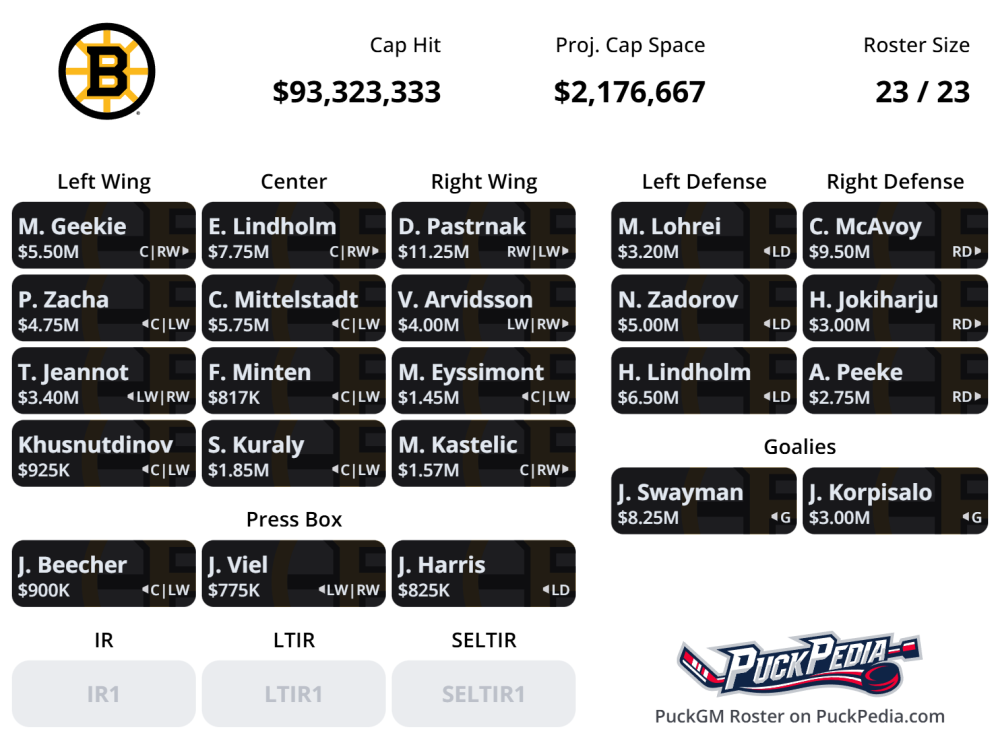
Buffalo Sabres
The Buffalo Sabres opened the season with 23 players on their roster, including 14 forwards, 6 defensemen, and 3 goalies, leaving them with $2.2M in projected cap space. Ukko-Pekka Luukkonen, Michael Kesselring, and Jordan Greenway begin the year on injured reserve. The team also carries $4.44M in dead cap from the Jeff Skinner buyout and $65K in SOIR for Noah Östlund.
Without any roster changes, this setup would allow Buffalo to add a $10M annual cap hit by the trade deadline.
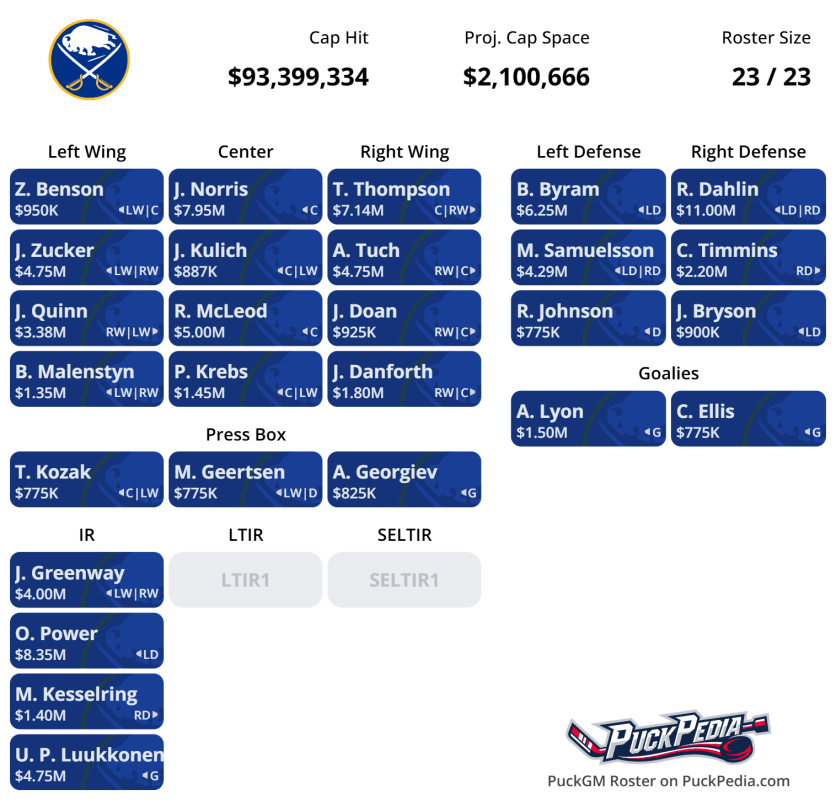
Note: Included in the above roster is Noah Östlund on SOIR.
Detroit Red Wings
The Detroit Red Wings opened the season with 23 players on their roster, including 13 forwards, 8 defensemen, and 2 goalies, leaving them with $11M in projected cap space. James van Riemsdyk begins the year on injured reserve. The team also carries $2.25M in dead cap from Justin Holl being buried, $1.06M from the Justin Abdelkader buyout, and an $871K bonus overage.
Without any roster changes, this setup would allow Detroit to add a $51M annual cap hit by the trade deadline.
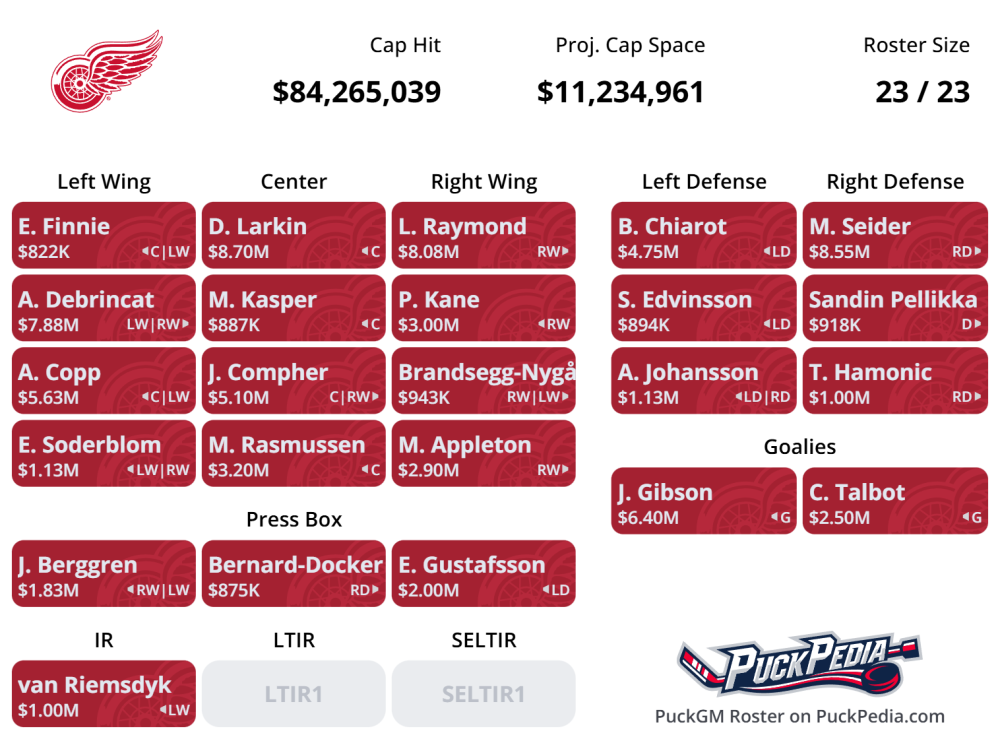
Florida Panthers
We believe the Florida Panthers roster release includes moves made after the opening submission, which initially featured Mackie Samoskevich sent down, no Noah Gregor, and both Matthew Tkachuk and Tomas Nosek on LTIR. This configuration was $4.55M over the cap, just $42K from an optimal LTI capture. Following that, Aleksander Barkov was added to LTIR, while Samoskevich was recalled and Gregor added.
With Barkov added to LTIR, Florida gained $3.8M in LTIR space. After recalling Samoskevich and adding Gregor today, they now have $2.27M in remaining LTIR space.
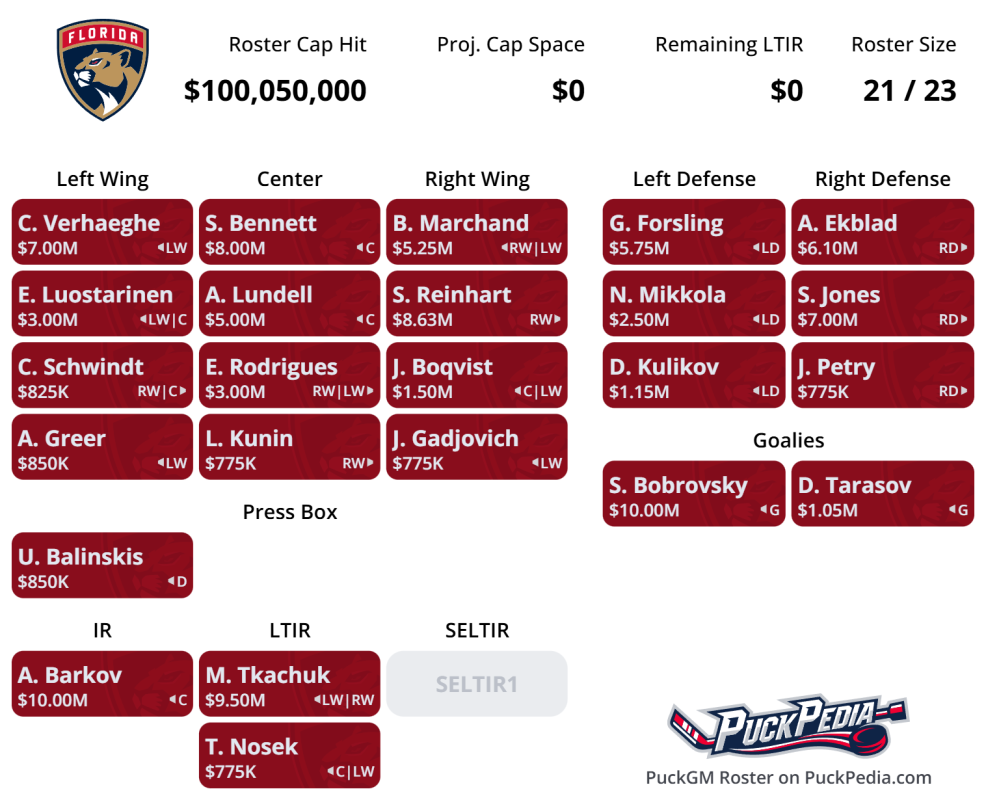
Montreal Canadiens
The Montreal Canadiens opened the season with 22 players on their roster, including 13 forwards, 7 defensemen, and 2 goalies, leaving them with $5.5M in projected cap space. The team also carries a $1.75M bonus overage.
Without any roster changes, this setup would allow Montreal to add a $25M annual cap hit by the trade deadline.

Ottawa Senators
The Ottawa Senators opened the season with 22 players on their roster, including 13 forwards, 7 defensemen, and 2 goalies, leaving them with $2.4M in projected cap space. Tyler Kleven and Drake Batherson begin the year on injured reserve. The team also carries $875K in dead cap from the Colin White buyout and $1M from Joonas Korpisalo’s retained salary.
Without any roster changes, this setup would allow Ottawa to add a $10.8M annual cap hit by the trade deadline.
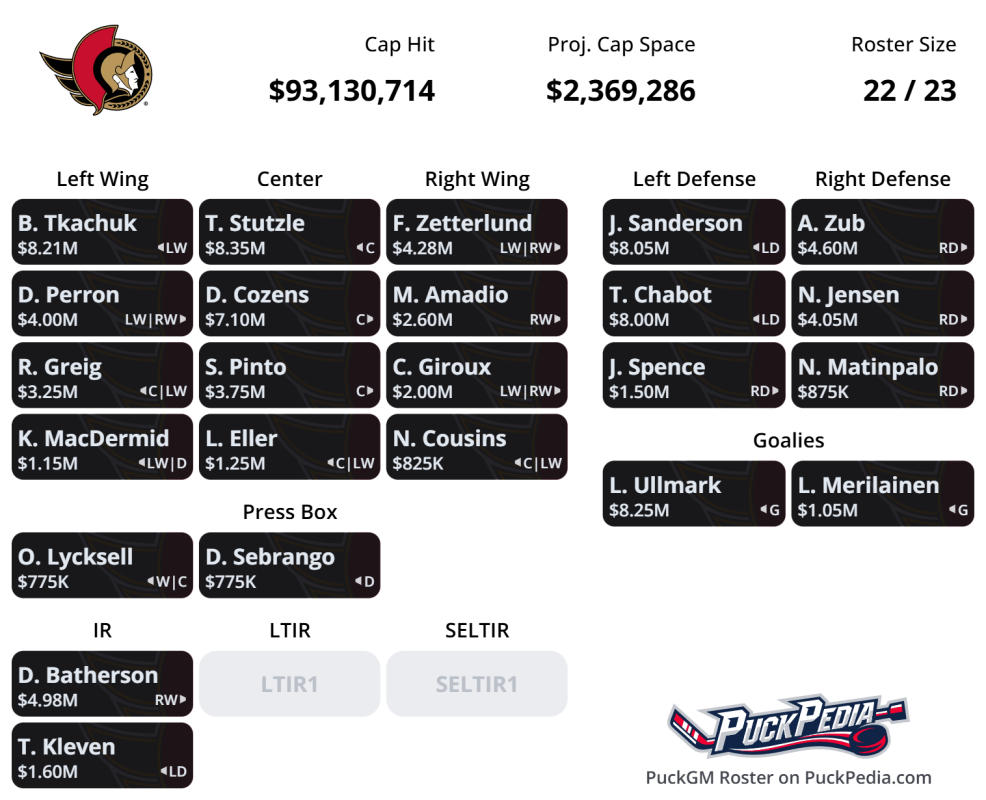
Tampa Bay Lightning
Despite their roster release, the Tampa Bay Lightning are believed to have opened the season with $405K in cap space and 22 players on the roster, after sending Max Crozier down. Following roster submission, the team likely placed Nick Paul on LTIR ($3.15M), allowing them to exceed the cap by $2.75M and recall Crozier. Zemgus Girgensons begins the year on injured reserve.
This leaves Tampa Bay with $2.375M in remaining LTIR space.

Toronto Maple Leafs
The Toronto Maple Leafs opened the season with $20K in cap space. Scott Laughton ($1.5M), Marshall Rifai ($775K), and Joseph Woll ($3.67M) begin the year on injured reserve.
Toronto is expected to place Rifai on LTIR, which would allow them to exceed the cap by $755K if they use LTIR. They could then recall Easton Cowan and assign Jacob Quillan on Wednesday.

Metropolitan Division
Carolina Hurricanes
The Carolina Hurricanes opened the season with 23 players on their roster, including 13 forwards, 7 defensemen, and 3 goalies, leaving them with $10.5M in projected cap space. Juha Jaaska is on season-opening IR with a $133K cap charge. The team also carries a $33K bonus overage.
Without any roster changes, this setup would allow Carolina to add a $48M annual cap hit by the trade deadline.
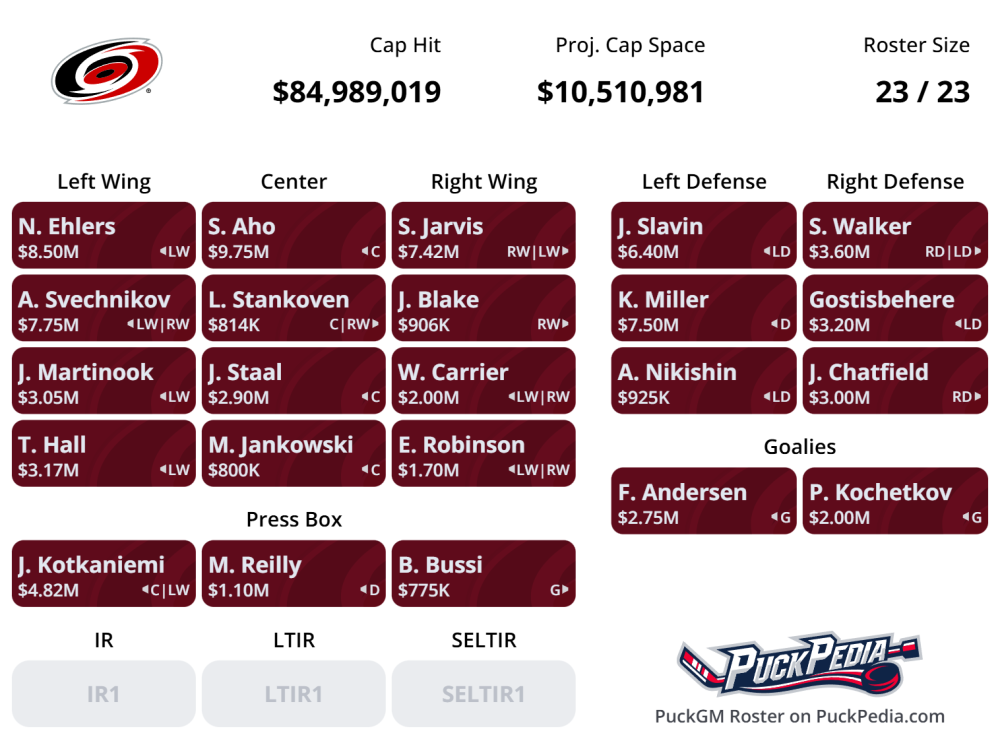
Columbus Blue Jackets
The Columbus Blue Jackets opened the season with 22 players on their roster, including 13 forwards, 7 defensemen, and 2 goalies, leaving them with $14M in projected cap space. The team carries $2.125M in dead cap from Ivan Fedotov being buried, $891K from the Alexander Wennberg buyout, and $533K from the Adam Boqvist buyout.
Without any roster changes, this setup would allow Columbus to add a $65M annual cap hit by the trade deadline.
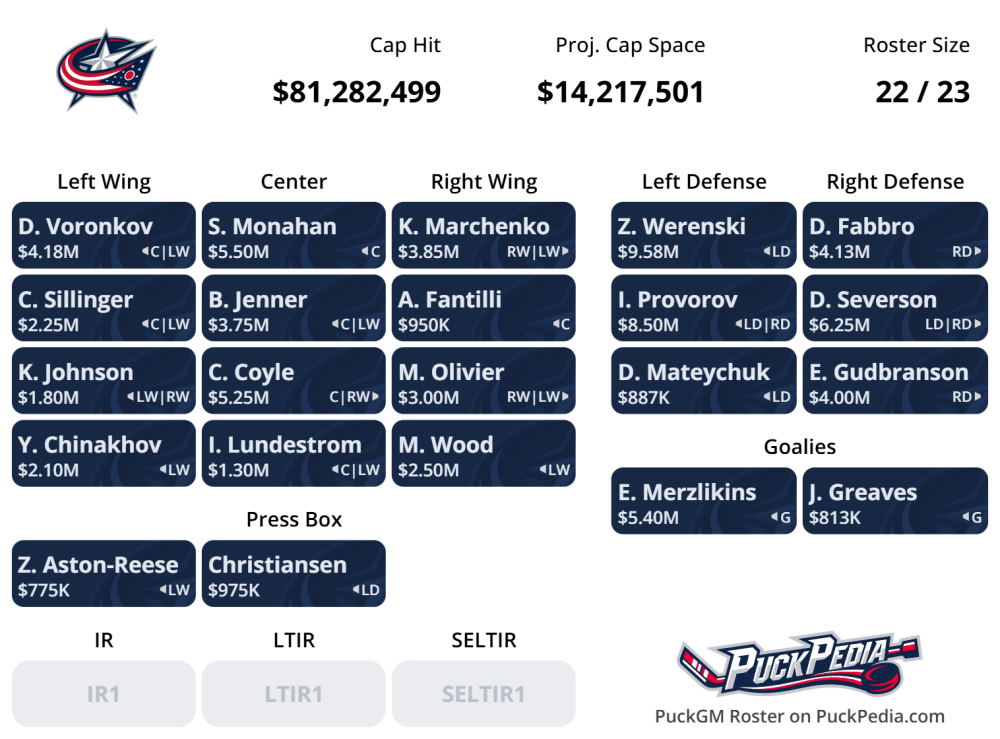
New Jersey Devils
As projected, the New Jersey Devils opened the season $3.996M over the cap with 23 active players, with Johnathan Kovacevic and Marc McLaughlin ($190K SOIR) on LTIR. Stefan Noesen begins the year on injured reserve, while Seamus Casey is on season-opening IR with a $238K cap charge. There is a $1M bonus overage from last season.
This configuration is $11K from an optimal LTI capture. The team can now place Noesen on LTIR and gain an additional $2.75M in LTIR space.
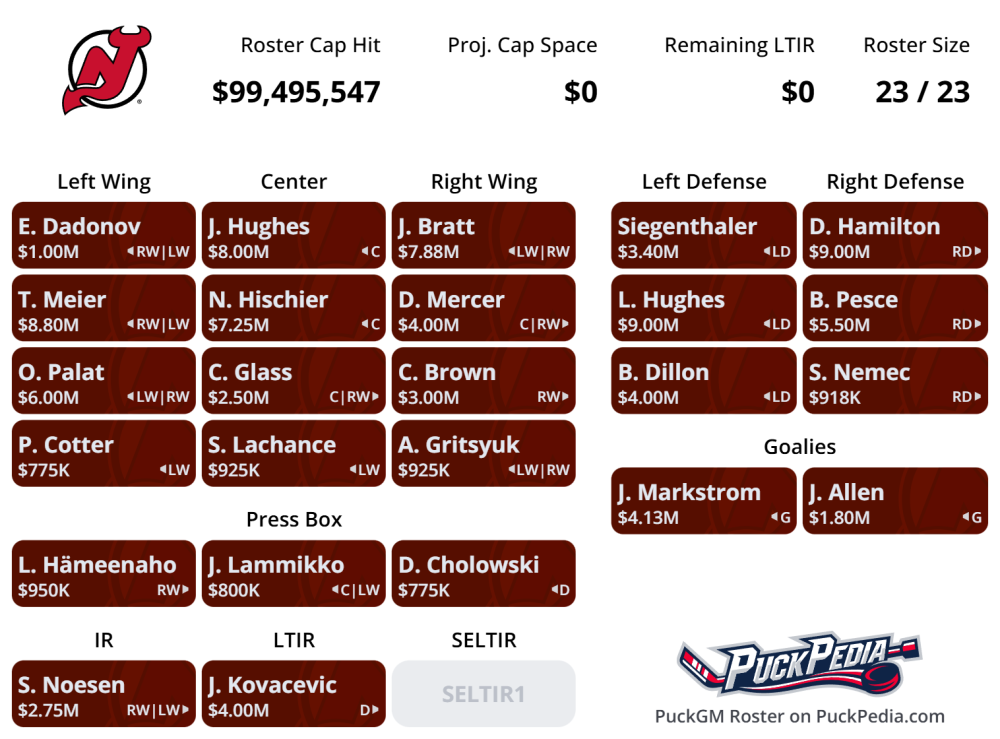
New York Islanders
The New York Islanders opened the season with 23 players on their roster, including 14 forwards, 7 defensemen, and 2 goalies, leaving them with $573K in projected cap space. Pierre Engvall and Semyon Varlamov begin the year on injured reserve, while Cal Ritchie is on season-opening IR with a $77K cap charge. The team also carries a $600K bonus overage.
Without any roster changes, this setup would allow New York to add a $2.6M annual cap hit by the trade deadline.

Note: In the above roster, Ritchie's $77K cap charge is also included under IR.
New York Rangers
The New York Rangers opened the season with 22 players on their roster, including 13 forwards, 7 defensemen, and 2 goalies, leaving them with $1.6M in projected cap space. The team currently has no dead cap charges.
This roster does not include Conor Sheary, who is expected to be registered tomorrow, which would reduce their available space by $775K.
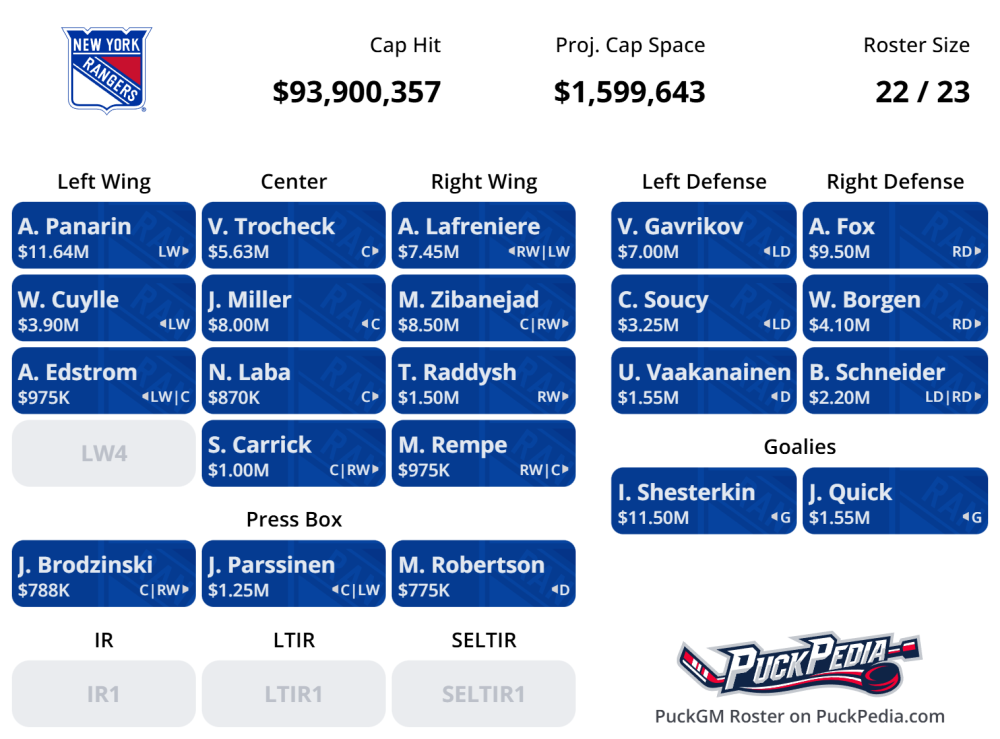
Philadelphia Flyers
The Philadelphia Flyers opened the season with 23 players on their roster, including 14 forwards, 7 defensemen, and 2 goalies, leaving them with $6.6M in projected cap space. Cam York and Rasmus Ristolainen begin the year on injured reserve. The team also carries $650K in buried cap from Carl Grundstrom, $1.76M from the Cam Atkinson buyout, and retained salary of $3.6M for Kevin Hayes and $1.5M for Scott Laughton.
Without any roster changes, this setup would allow Philadelphia to add a $30M annual cap hit by the trade deadline.
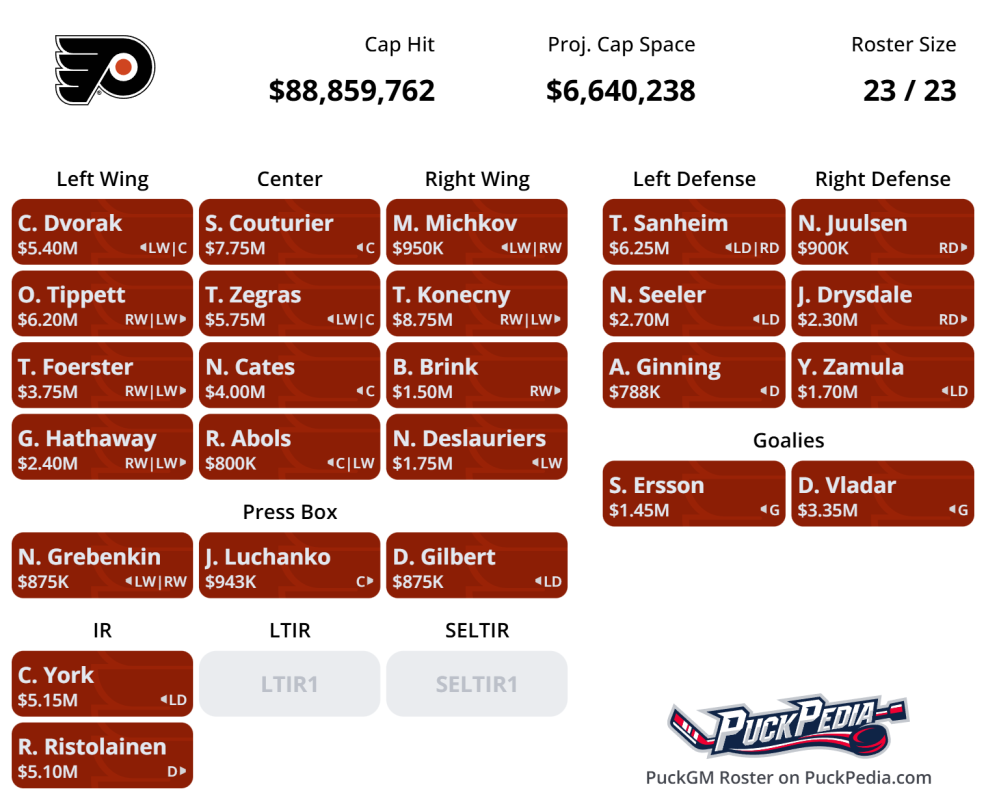
Pittsburgh Penguins
The Pittsburgh Penguins opened the season with 23 players on their roster, including 13 forwards, 8 defensemen, and 2 goalies, leaving them with $11M in projected cap space. Bryan Rust and Kevin Hayes begin the year on injured reserve, while Joel Blomqvist ($342K), Jack St. Ivany ($230K), and Rutger McGroarty ($148K) are on season-opening IR.
Without any roster changes, this setup would allow Pittsburgh to add a $51M annual cap hit by the trade deadline.

Washington Capitals
The Washington Capitals opened the season with 23 players on their roster, including 13 forwards, 8 defensemen, and 2 goalies, leaving them with $3.3M in projected cap space. Dylan McIlrath begins the year on injured reserve. The team has no dead cap hit.
Without any roster changes, this setup would allow Washington to add a $15M annual cap hit by the trade deadline.

Western Conference
Central Division
Chicago Blackhawks
The Chicago Blackhawks opened the season with 23 players on their roster, including 13 forwards, 8 defensemen, and 2 goalies, leaving them with $14M in projected cap space. Landon Slaggert, Joey Anderson, Shea Weber, and Laurent Brossoit begin the year on injured reserve. The team also carries $3.2M in dead cap from the T.J. Brodie buyout and $2.5M from Seth Jones’ retained salary.
Without any roster changes, this setup would allow Chicago to add a $65M annual cap hit by the trade deadline.
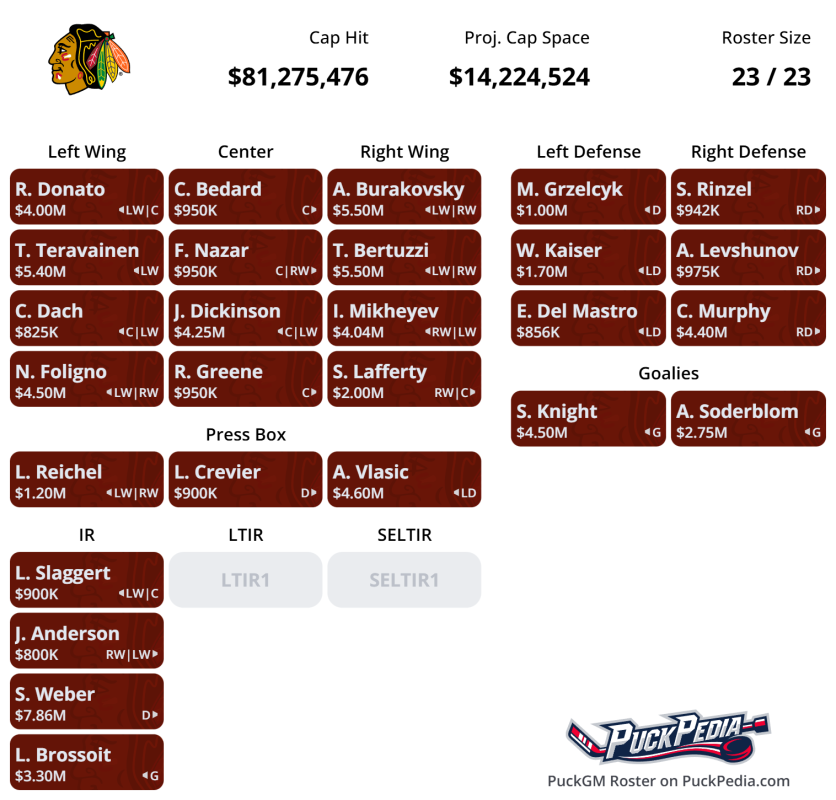
Colorado Avalanche
The Colorado Avalanche opened the season with 23 players on their roster, including 13 forwards, 7 defensemen, and 3 goalies, leaving them with $277K in projected cap space. Logan O'Connor and Ilya Solovyov begin the year on injured reserve, while Nikita Prishchepov ($76K) and Jacob MacDonald ($4K) are on season-opening IR.
If O'Connor were placed on LTIR, Colorado could exceed the cap by $2.2M.

Dallas Stars
The Dallas Stars opened the season with 21 players on their roster, including 12 forwards, 7 defensemen, and 2 goalies, leaving them with $148K in projected cap space. Jamie Benn ($1M) and Oskar Back ($825K) begin the year on injured reserve. The team also carries $1.4M in dead cap from the Ryan Suter buyout and a $368K bonus overage.
If Benn or Back are placed on LTIR, Dallas can exceed the cap by $148K less than their combined cap hit, allowing them to recall Lian Bichsel.

Minnesota Wild
The Minnesota Wild opened the season with 22 players on their roster, including 13 forwards, 7 defensemen, and 2 goalies, leaving them with $4.4M in projected cap space. Mats Zuccarello and Jonas Brodin begin the year on injured reserve. The team also carries $833K in dead cap from the Zach Parise buyout, $833K from the Ryan Suter buyout, and a $1.1M bonus overage.
Without any roster changes, this setup would allow Minnesota to add a $20M annual cap hit by the trade deadline.
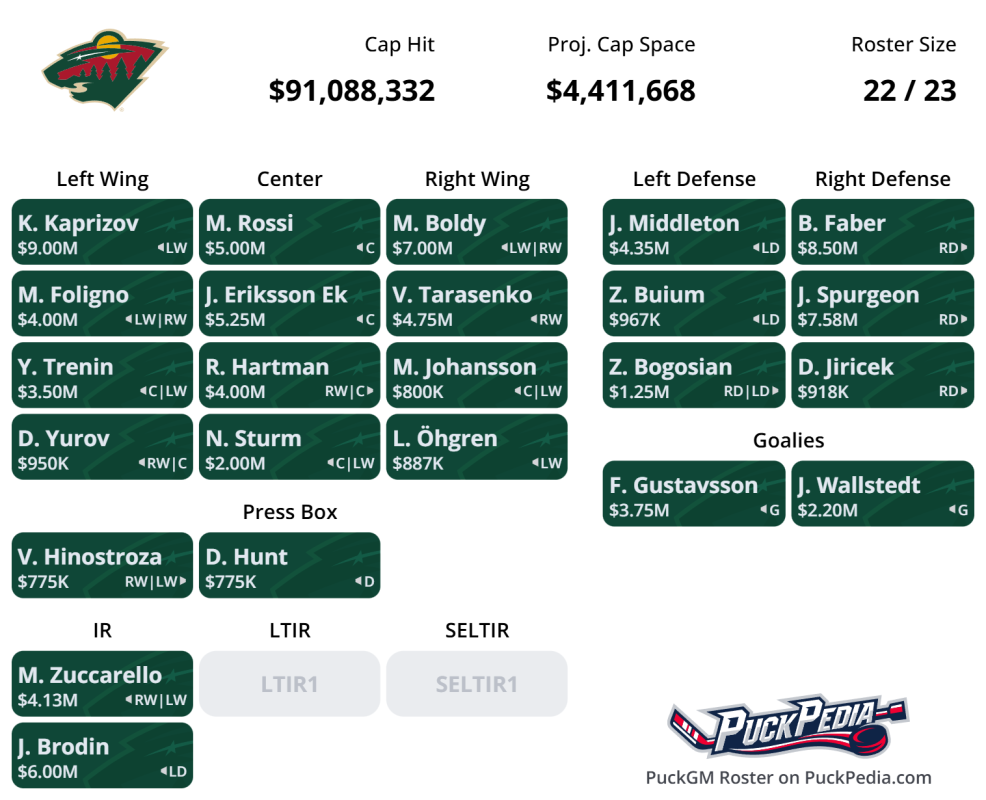
Nashville Predators
The Nashville Predators opened the season with 22 players on their roster, including 13 forwards, 7 defensemen, and 2 goalies, leaving them with $5.4M in projected cap space. Luke Evangelista and Nicolas Hague begin the year on injured reserve, while Matthew Wood is on season-opening IR with a $94K cap charge. The team also carries dead cap from the Duchene buyout ($6.6M) and the Turris buyout ($2M), plus retained salaries of $1.4M for Colton Sissons and $250K for Mattias Ekholm.
Without any roster changes, this setup would allow Nashville to add a $15.5M annual cap hit by the trade deadline.
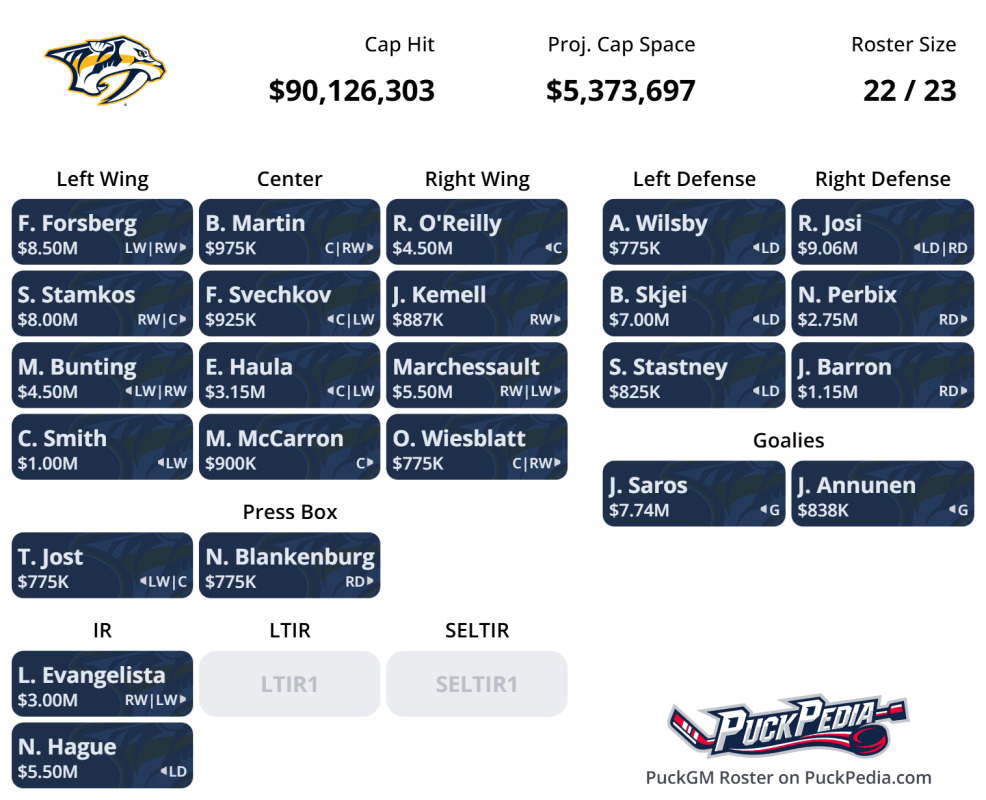
St. Louis Blues
The St. Louis Blues opened the season with 23 players on their roster, including 14 forwards, 7 defensemen, and 2 goalies, leaving them with $625K in projected cap space. Torey Krug begins the year on injured reserve with a $6.5M cap hit. The team also carries a $2.15M bonus overage.
If Krug is placed on season-ending LTIR, St. Louis could exceed the cap by $5.875M.
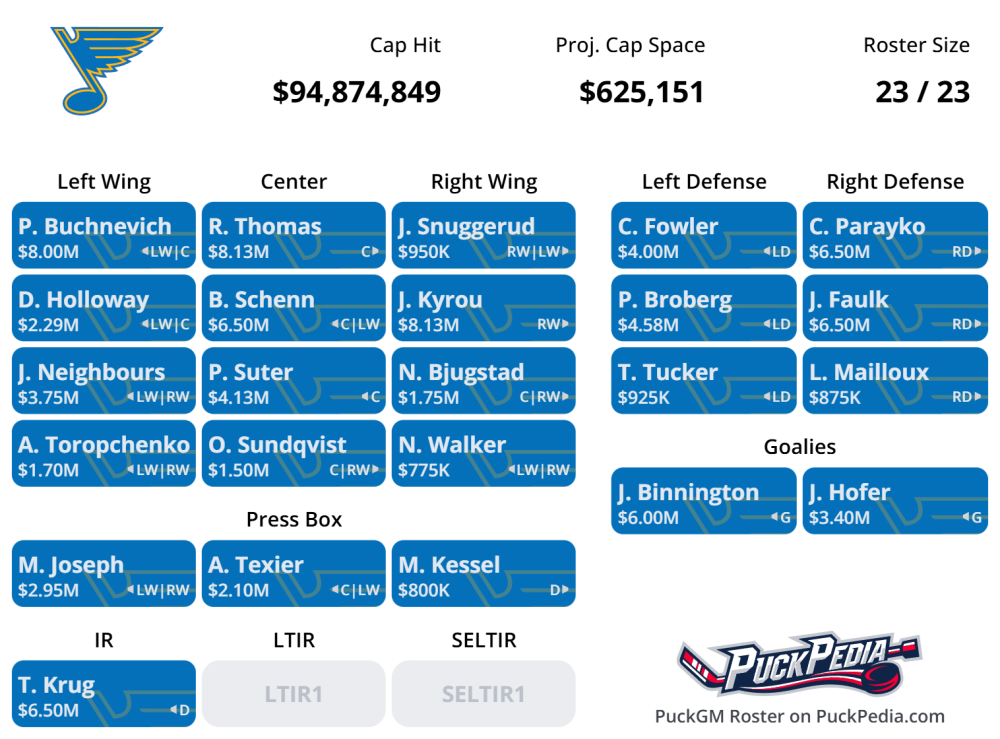
Utah Mammoth
The Utah Mammoth opened the season with 23 players on their roster, including 13 forwards, 8 defensemen, and 2 goalies, leaving them with $4.5M in projected cap space. Alex Kerfoot, Liam O'Brien, and Juuso Välimäki begin the year on injured reserve. The team also carries $650K in dead cap from the Oliver Ekman-Larsson buyout and $800K retained from Connor Ingram.
Without any roster changes, this setup would allow Utah to add a $21M annual cap hit by the trade deadline.
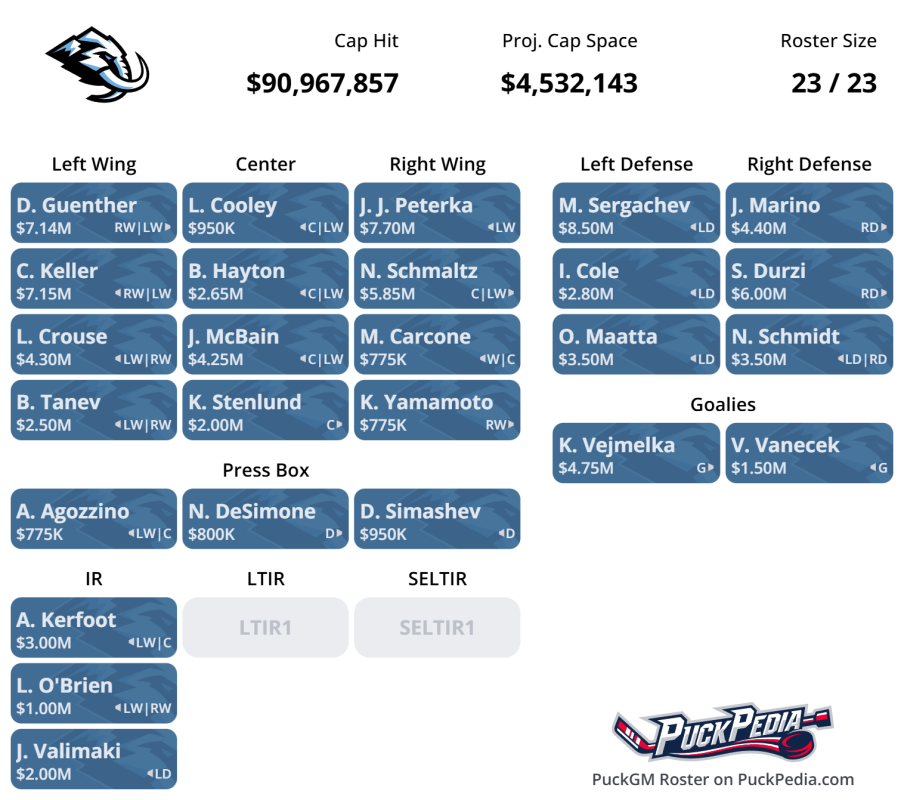
Winnipeg Jets
The Winnipeg Jets opened the season with 23 players on their roster, including 14 forwards, 7 defensemen, and 2 goalies, leaving them with $1.4M in projected cap space. Dylan Samberg, Adam Lowry, Cole Perfetti, and Jonathan Toews begin the year on injured reserve. The team also carries $1.62M in dead cap from the Nate Schmidt buyout.
Without any roster changes, this setup would allow Winnipeg to add a $6.3M annual cap hit by the trade deadline.
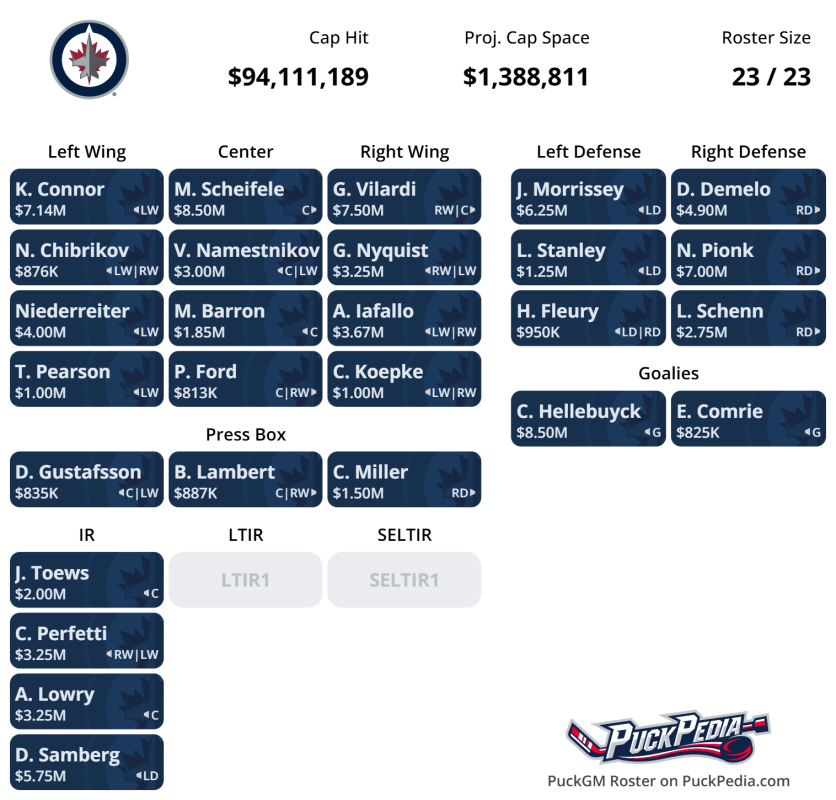
Pacific Division
Anaheim Ducks
The Anaheim Ducks opened the season with 23 players on their roster, including 14 forwards, 6 defensemen, and 3 goalies, leaving them with $13M in projected cap space. Jansen Harkins begins the year on injured reserve. The team also carries $2.5M in retained salary from Fowler.
Without any roster changes, this setup would allow Anaheim to add a $58M annual cap hit by the trade deadline.
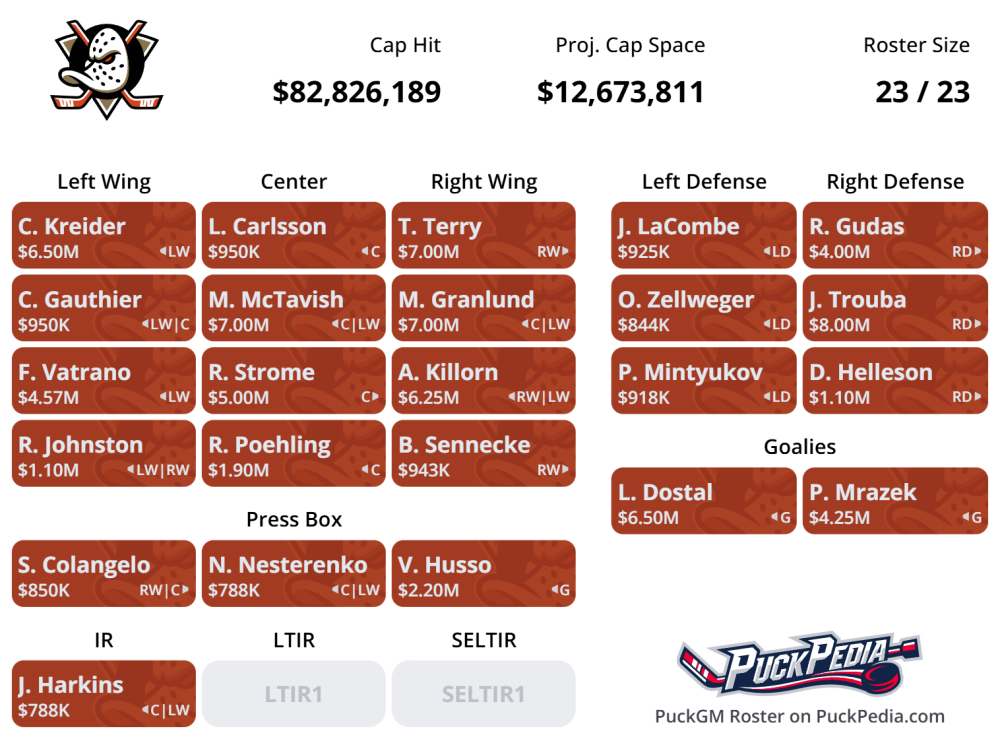
Calgary Flames
The Calgary Flames opened the season with 23 players on their roster, including 13 forwards, 8 defensemen, and 2 goalies, leaving them with $9.7M in projected cap space. Jonathan Huberdeau and Martin Pospisil begin the year on injured reserve. The team also carries $1.875M in retained salary from Jacob Markstrom.
Without any roster changes, this setup would allow Calgary to add a $44M annual cap hit by the trade deadline.
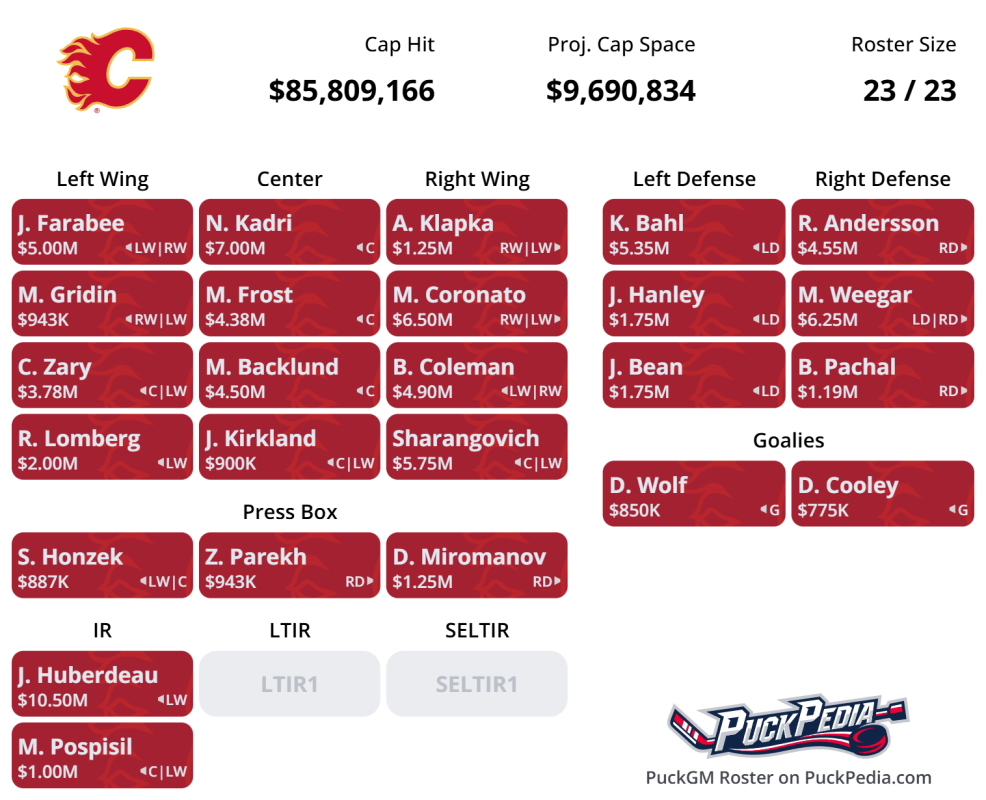
Edmonton Oilers
As expected, the Edmonton Oilers sent down David Tomasek and Isaac Howard, and recalled James Hamblin for their opening roster, leaving them with $834 in cap space. Mattias Janmark begins the year on injured reserve.
With Zach Hyman added to LTIR, Edmonton can exceed the cap by $3.8M (within $834 of an optimal LTI capture), then recall Howard and Tomasek while assigning Hamblin on Wednesday.

Los Angeles Kings
The Los Angeles Kings opened the season with 22 players on their roster, including 13 forwards, 7 defensemen, and 2 goalies, leaving them with $1.9M in projected cap space. Corey Perry and Kyle Burroughs begin the year on injured reserve. The team also carries $600K in dead cap from the Mike Richards buyout and a $212.5K bonus overage.
Without any roster changes, this setup would allow Los Angeles to add an $8.7M annual cap hit by the trade deadline.

San Jose Sharks
The San Jose Sharks opened the season with $1.7M in cap space. Carey Price began on Season Ending LTIR, while Ryan Ellis, Egor Afanasyev, and Logan Couture begin the year on injured reserve; Lucas Carlsson ($113K) and Jack Thompson ($454K) are on season-opening IR.
The team also carries dead cap from buyouts of Marc-Édouard Vlasic ($4.7M), Martin Jones ($1.7M), and Nicolai Knyzhov ($467K), along with retained salaries for Erik Karlsson ($1.5M) and Tomas Hertl ($1.4M).
Seattle Kraken
The Seattle Kraken opened the season with 23 players on their roster, including 13 forwards, 7 defensemen, and 3 goalies, leaving them with $2.5M in projected cap space. Kaapo Kakko and Ryker Evans begin the year on injured reserve. The team also carries a $379K buyout charge for Joe Veleno.
Without any roster changes, this setup would allow Seattle to add an $11M annual cap hit by the trade deadline.
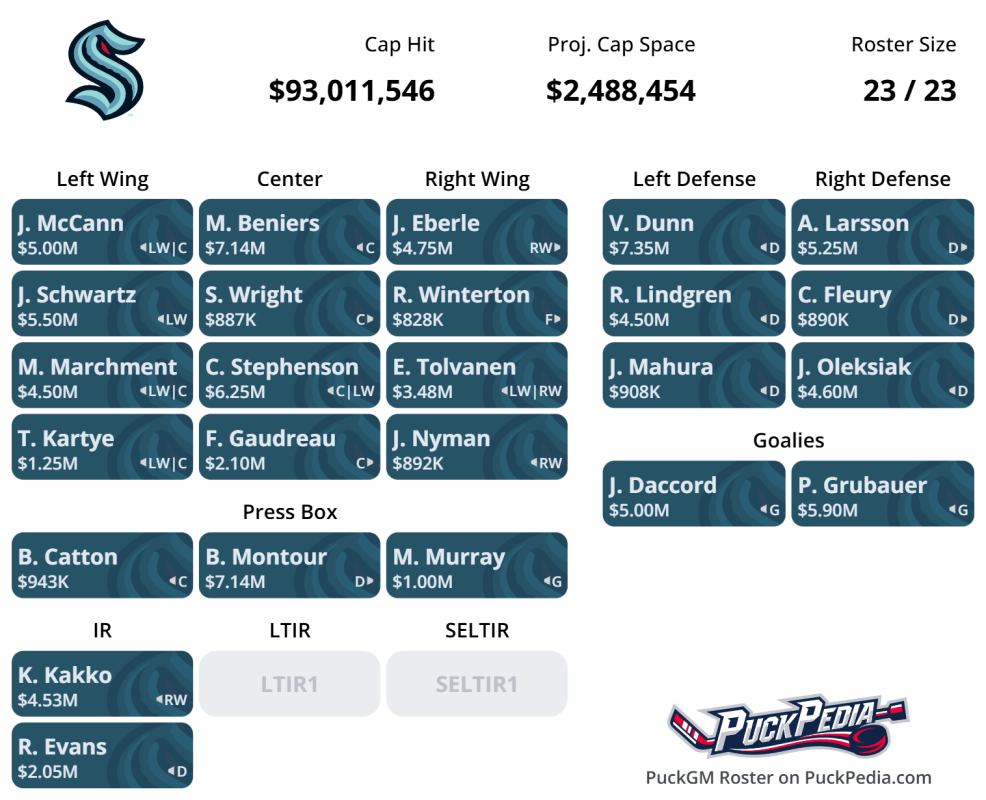
Vancouver Canucks
The Vancouver Canucks opened the season with 23 players on their roster, including 14 forwards, 7 defensemen, and 2 goalies, leaving them with $1.3M in projected cap space. Nils Höglander begins the year on injured reserve, while Guillaume Brisebois is on season-opening IR with an $89K cap charge. The team also carries a $712.5K retained salary for Ilya Mikheyev and $4.76M for Ekman-Larsson's buyout.
Without any roster changes, this setup would allow Vancouver to add a $6.1M annual cap hit by the trade deadline.

Note: In the above roster, Brisbois' $89K cap charge is also included under IR.
Vegas Golden Knights
We believe the Vegas Golden Knights opening roster included Jeremy Davies ($1.15M) and was $8.78M over the cap with 23 active players, just $24K from an optimal LTIR capture. Alex Pietrangelo begins the season on season-ending LTIR.
We expect Davies to be placed on waivers and assigned on Wednesday, freeing $1.15M in cap space and allowing Vegas to sign RFA Alexander Holtz.


